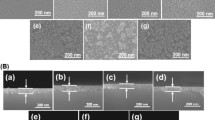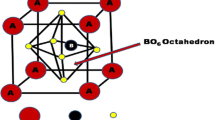Abstract
In continuation of our previous work [J. Ovenstone, P.J. Titler, R. Withnall and J. Silver, J. Phys. Chem. B, 105, 7170 (2001)] we report the following results. Amorphous europium-doped titania phosphors (Ti1−3xEu4xO2) were prepared with europium concentrations from x = 0.000397 to x = 0.143. From investigations using photoluminescence (PL), it was deduced that the luminescence was due to a europium/titanium compound rather than from a europium-containing precipitate dispersed within a titania precipitate. PL brightness was shown to increase linearly to a concentration of x = 0.0159 before quenching began, and the rate of increase of brightness dropped. Brightness then continued to rise (almost linearly) from x = 0.0238 to x = 0.143. Under electron beam excitation these phosphors showed weak cathodoluminescence; for the amorphous materials no quenching was observed. For the crystalline materials (prepared by annealing the amorphous materials at high temperature) no red luminescence was observed above a concentration of x = 0.00318; however, some faint red luminescence was observed below this concentration. In addition, some faint blue emission was observed in crystalline samples that had no red luminescence, indicating the presence of small amounts of Eu2+ ions. This was attributed to reduction of the Eu3+ ions in the electron beam. Europium doping was shown to increase the size of the band gap in the amorphous materials, but had little effect on the band gap of the crystalline powders.
Similar content being viewed by others
References
L. Ozawa, Cathodoluminescence Theory and Applications, Chap. 4 (VCH, 1990).
T. Kano, Phosphor Handbook, Chap. 3 (CRC 1998).
J. Ovenstone, J. Mater. Sci. 36, 1325 (2001).
J. Ovenstone, P.J. Titler, R. Whitnall, and J. Silver, J. Phys. Chem. B 105, 7170 (2001).
E. Sanchez and T. Lopez, Mater. Lett. 25, 271 (1995).
J. Silver, M.I. Martino-Rubio, T.G. Ireland, G.R. Fern, and R. Withnall (unpublished).
J. Silver, A. Newport, M.I. Martinez-Rubio, T.G. Ireland, P.J. Marsh, R. Withnall, and A. Vecht, Society for Information Display Conference, 4–8 June, San Jose, CA (2001).
C.H. Seager and D.R. Tallant, Proceedings of MRS Spring Meeting, San Francisco, CA (2001).
Author information
Authors and Affiliations
Rights and permissions
About this article
Cite this article
Ovenstone, J., Titler, P.J., Withnall, R. et al. Luminescence in europium-doped titania: Part II. High concentration range of Eu3+. Journal of Materials Research 17, 2524–2531 (2002). https://doi.org/10.1557/JMR.2002.0367
Received:
Accepted:
Published:
Issue Date:
DOI: https://doi.org/10.1557/JMR.2002.0367




